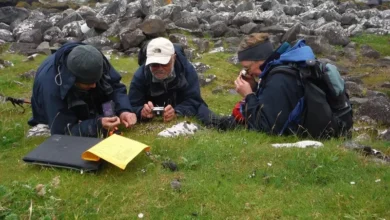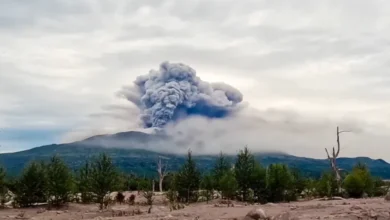Is climate change fuelling Canada’s wildfires?

Intense wildfires are blazing across Canada with thousands evacuated and smoke blown as far south as the US state of Georgia, creating hazardous air quality for millions.
Canada is projected to see its largest area on record burned by wildfires this year.
The impact is being felt hundreds of miles away, most keenly in Toronto and New York.
“We are now experiencing a new reality,” said Canada’s Natural Resources Minister Jonathan Wilkinson.
We look at the role a changing climate has in what is happening.
How did the wildfires in Canada start?
The first local state of emergency was declared in Alberta on 4 May, and hundreds of blazes have since broken out across the country, with more than 400 active fires as of 7 June.
Most of the more than 2,000 fires that Canada has seen this year are thought to have been started by humans.
Some, particularly in Quebec, were sparked by lightning strikes.
Dead trees left to stand and poor forestry management have also previously been blamed for causing a serious fire risk.
Experts say the modern practice of trying to totally suppress fires can stop forests creating natural firebreaks that would historically have reduced wildfire spread.
Are the fires caused by climate change?
Each wildfire cannot automatically be linked directly to climate change. The science is complicated and human factors like how we manage land and forests also contribute.
But scientists say that climate change is making weather conditions like heat and drought that lead to wildfires more likely.

Robert Scheller, professor of forestry at North Carolina State University, says: “The climate signal is very strong. We are seeing both a larger area burned, and more severe fires.”
Spring in Canada has been much warmer and drier than usual, creating a tinder-dry environment for these vast fires.
In Halifax, in the eastern province of Nova Scotia, temperatures last week reached 33C, around 10 degrees higher than normal for the time of year.
Parts of the country, including Alberta and Saskatchewan, have been in drought since 2020.
“The vegetation in the forests is exceptionally dry,” says climate scientist Daniel Swain at UCLA, which has meant that a higher fraction of lightning strikes has resulted in forest fires.
Experts link the high temperatures to record-breaking spring heat seen in other parts of the northern hemisphere, including Spain, Portugal, Morocco, Algeria and Siberia.
Last year scientists concluded that high temperatures exacerbated by climate change made drought in the northern hemisphere more likely.
Wildfires also contribute to greenhouse gas emissions, those gases that warm our atmosphere.
Emissions from the Canada wildfires in May reached 54.8 million tonnes, which is more than double the past records for that month since estimates began in 2003, according to the Copernicus Atmosphere Monitoring Service.
How long will the smoke and fires last?
A storm system and swirling low-pressure weather has been pushing hazy, smoggy air into parts of Canada and the US, hundreds of miles away from fires.
Those weather conditions may ease in the next few days, meaning the skies could begin to clear, but for areas closer to the fires, the smoke is likely to continue.
The Canadian government says the risk of wildfires is expected to recede in Quebec and Ontario in July, but the potential is expected to expand next month into the Yukon in north-western Canada.
And the heat and dry weather are projected to last throughout the summer, meaning the risk of fire is unlikely to decrease soon.
With climate change, is it going to get progressively worse every year?
Scientists predict wildfires will become more frequent and intense in future because of the combined effects of land use and climate change.
But Prof Scheller says “there will always be year-to-year variation”.
While wildfire frequency varies from region to region, the number of acres burned by these conflagrations has risen notably in recent decades in North America.
That trend is expected to continue for decades as climate change worsens, causing higher temperatures and drier conditions, says Prof Scheller.











